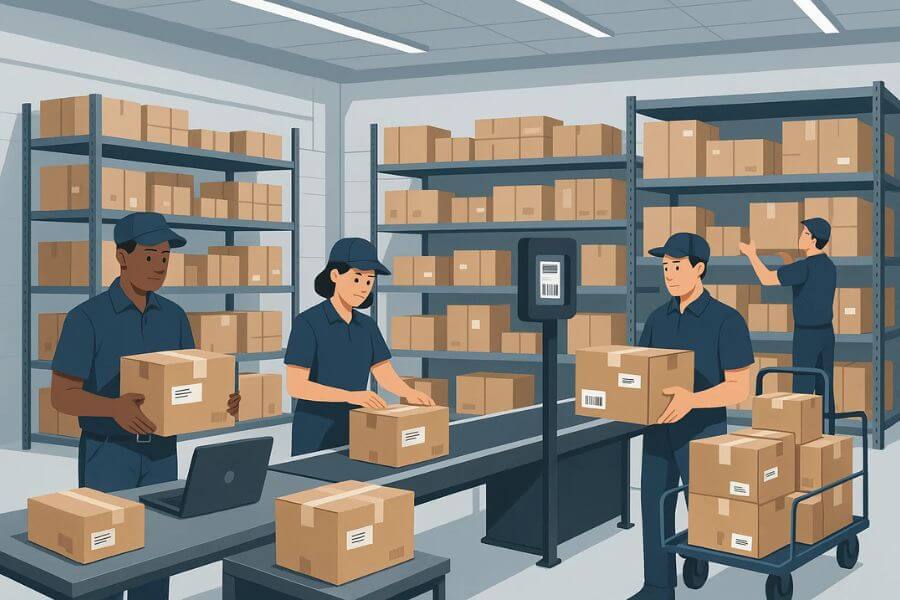Supply chain businesses often grapple with the dilemma of maintaining enough stock to meet customer demands without drowning in excess inventory. Surprisingly, a 2022 survey by Avery Dennison, a global material science company, revealed a shocking truth: despite efforts to sell surplus goods, a whopping 8% of excess stock worldwide ends up as waste, amounting to a staggering $163 billion annually – more than the GDP of Croatia, Costa Rica, and Iceland combined.
This is where the concept of Just-In-Time (JIT) inventory management steps in. JIT inventory systems are a streamlined approach to managing inventory, aiming to minimize waste and increase efficiency in the supply chain. In this blog, we’ll explore the benefits of just-in-time inventory management and how it propels e-commerce.
What is a Just-In-Time Inventory System?
A just-in-time inventory system is a management strategy that aims to optimize the flow of goods throughout the supply chain by producing or purchasing items just in time for their actual use or sale. The primary goal of just-in-time in e-commerce is to minimize inventory carrying costs while ensuring that products are available when needed. This approach is particularly relevant in manufacturing and retail industries, including e-commerce, where efficiency and responsiveness to customer demand are critical.
Here are some essential components of a JIT inventory management system:
Demand Forecasting – Accurate forecasting of customer demand is critical to JIT. Businesses need to analyze historical data, market trends, and other factors to predict the quantity of products customers are likely to purchase.
Supplier Relationships – Strong partnerships with suppliers are essential. JIT relies on timely deliveries of materials, and close collaboration with suppliers ensures a smooth flow of goods through the supply chain.
Reduced Lead Times – Minimizing the time it takes for a product to move from initiation to delivery is a key component. This involves reducing lead times in procurement, production, and distribution processes.
Continuous Flow – JIT emphasizes a continuous and smooth flow of materials and products through the production and distribution processes. This contrasts with batch production, where items are produced in large quantities before moving to the next stage.
Minimized Inventory Levels – JIT seeks to keep inventory levels as low as possible without risking stockouts. This helps reduce holding costs, such as storage expenses and the risk of obsolescence.
Flexible Production – JIT systems are designed for flexible and adaptable production processes. This allows businesses to adjust production schedules quickly in response to changes in customer demand or market conditions.
Kanban System – Implementing a Kanban system, which is a visual management tool, aids in controlling and signaling the need for materials in a JIT system.
Pull System – JIT operates on a pull system where production is initiated in response to customer demand. This contrasts with a push system where goods are produced based on forecasts.
Top 5 Benefits of JIT Inventory Systems in eCommerce
Navigating the balance between having enough products to meet customer demand and avoiding excess stock can be a game-changer for businesses. By effectively addressing the pitfalls of both overstocking and understocking, companies stand to gain a substantial 10% reduction in inventory costs. The impact of surplus inventory goes beyond financial implications; it has the potential to tie up valuable capital, limiting a company’s ability to invest in new products, emerging technologies, or innovative marketing initiatives.
Enter the realm of JIT inventory management, a strategy designed to revolutionize how businesses handle their inventory. JIT brings a plethora of benefits to the table, and here are some of the most important ones:
1. Improved Product Quality
Just-in-time inventory systems are reshaping how you perceive and achieve product quality in manufacturing. The key lies in embracing smaller, more manageable production runs, allowing businesses to focus intensely on inspecting the promptly identifying defects throughout the production process. This strategic shift emphasizes frequent and thorough checks, enabling businesses to swiftly rectify defects, preventing their escalation, and minimizing impacts on the broader inventory.
The philosophy of smaller batch sizes in JIT isn’t just about logistics; it cultivates a culture dedicated to continual improvement. This means defects aren’t just fixed; the entire production process evolves to prevent similar issues in the future. Beyond the production floor, JIT’s influence extends to reducing work-in-progress inventory. This reduction streamlines quality control, ensuring each unit gets meticulous attention adhering to stringent quality standards.
2. Lower Costs
Just-in-time inventory systems offer businesses a powerful tool to lower costs by strategically managing their inventory. By minimizing excess inventory, companies can avoid the hefty expenses associated with holding onto surplus goods. Traditional models often involve large stockpiles, tying up capital in storage, and increasing holding costs. In contrast, JIT ensures that inventory levels are kept at the minimum necessary, freeing up capital that can be redirected towards more strategic investments.
One of the significant benefits of just-in-time inventory is cost reduction from storage expenses. Excess inventory demands substantial warehouse space, leading to expenses related to leasing and maintenance. As reported by the Wall Street Journal, warehouse rental prices in the U.S. soared to an average of $9.59 per square foot in the second quarter of 2023, with expectations of further increases. By implementing JIT and cutting down on surplus storage, businesses can substantially slash these costs. This not only saves money but also promotes a more efficient and organized warehouse, boosting overall operational efficiency.
3. Smoother Production Flow
In manufacturing, one of the main just-in-time inventory benefits is to guarantee a steady and efficient production process. This happens through two main strategic: cutting down on setup times and opting for smaller production batches.
Firstly, JIT focuses on reducing setup times, which is the time needed to switch between different production runs. By making adjustments to machinery swiftly and efficiently, downtime is minimized. This means the manufacturing process becomes more efficient, allowing businesses to respond quickly to changes in customer demand.
Secondly, JIT encourages the use of smaller production batches. Instead of making a lot of products in one go, businesses produce in smaller increments. This not only avoids the risk of making too much but also makes the production process more flexible. Smaller batches mean quicker adjustments based on real-time demand, making sure resources are used wisely and plans stay adaptable.
4. Greater Productivity
The focus on efficiency and waste reduction in JIT inventory systems directly translates into improved overall productivity. This approach involves fine-tuning production processes to minimize waste and maximize efficiency, allowing businesses to achieve higher output with the same or even fewer resources.
Optimizing production schedules is a key component of JIT’s productivity benefits. By aligning production with actual demand and reducing unnecessary downtime, businesses can enhance their capacity to deliver more products without overburdening their resources. This strategic scheduling guarantees that production efforts are precisely tailored to meet customer needs, maximizing the value derived from every resource.
Moreover, JIT places a strong emphasis on resource utilization. This involves efficiently managing raw materials, machinery, and labor to eliminate inefficiencies and reduce waste. As a result, businesses can achieve a higher level of productivity by making the most out of their available resources.
5. Inventory Waste Reduction
At the heart of JIT inventory systems lies a fundamental principle: minimizing waste. This goes beyond merely cutting down on excess inventory; it encompasses a holistic approach to reducing waste in time, resources, and defective products. The ultimate goal is to cultivate a more sustainable and environmentally conscious approach to business operations.
JIT’s commitment to waste reduction starts with a keen focus on time efficiency. By streamlining processes and minimizing unnecessary delays, JIT ensures that time is utilized purposefully, eliminating idle periods that contribute to inefficiency. This time-conscious approach not only enhances overall productivity but also aligns with the broader goal of minimizing waste in the operational timeline.
Furthermore, JIT addresses waste through a stringent approach to defective products. By promoting smaller production batches and maintaining a keen focus on quality control, businesses can minimize the production of defective items. This not only preserves resources that would otherwise be wasted on flawed products but also aligns with a broader commitment to delivering high-quality goods to customers.
Conclusion
Think of JIT as a game-changer – it’s not just about managing stock; it’s about crafting a more efficient and nimble e-commerce journey. Imagine a scenario where businesses waste less, respond faster, and align seamlessly with what customers crave.
In the evolving world of online shopping, JIT nudges us to consider a future where resources are used wisely, excess is trimmed, and customer satisfaction is the compass guiding decisions. It’s a straightforward yet powerful approach that prompts businesses to adapt to the ever-shifting dynamics of digital commerce.
Revolutionize your global logistics game with Simple Global, where we not only simplify but also optimize your operations. Say goodbye to excess stock and hello to a future where your inventory is precisely where it needs to be, precisely when it’s needed!





